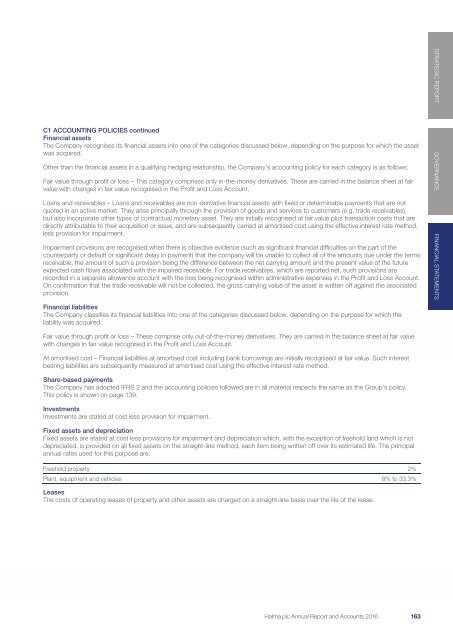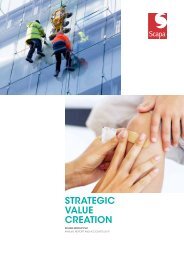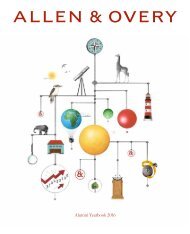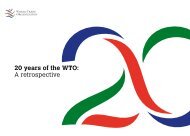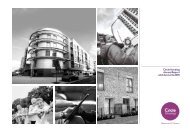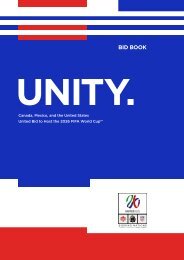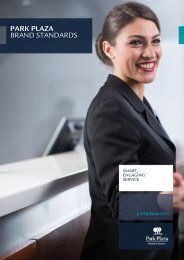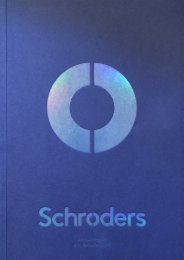You also want an ePaper? Increase the reach of your titles
YUMPU automatically turns print PDFs into web optimized ePapers that Google loves.
Notes to the Company Accounts continued<br />
C1 ACCOUNTING POLICIES continued<br />
Financial assets<br />
The Company recognises its financial assets into one of the categories discussed below, depending on the purpose for which the asset<br />
was acquired.<br />
Other than the financial assets in a qualifying hedging relationship, the Company's accounting policy for each category is as follows:<br />
Fair value through profit or loss – This category comprises only in-the-money derivatives. These are carried in the balance sheet at fair<br />
value with changes in fair value recognised in the Profit and Loss Account.<br />
Loans and receivables – Loans and receivables are non-derivative financial assets with fixed or determinable payments that are not<br />
quoted in an active market. They arise principally through the provision of goods and services to customers (e.g. trade receivables),<br />
but also incorporate other types of contractual monetary asset. They are initially recognised at fair value plus transaction costs that are<br />
directly attributable to their acquisition or issue, and are subsequently carried at amortised cost using the effective interest rate method,<br />
less provision for impairment.<br />
Impairment provisions are recognised when there is objective evidence (such as significant financial difficulties on the part of the<br />
counterparty or default or significant delay in payment) that the company will be unable to collect all of the amounts due under the terms<br />
receivable, the amount of such a provision being the difference between the net carrying amount and the present value of the future<br />
expected cash flows associated with the impaired receivable. For trade receivables, which are reported net, such provisions are<br />
recorded in a separate allowance account with the loss being recognised within administrative expenses in the Profit and Loss Account.<br />
On confirmation that the trade receivable will not be collected, the gross carrying value of the asset is written off against the associated<br />
provision.<br />
Financial liabilities<br />
The Company classifies its financial liabilities into one of the categories discussed below, depending on the purpose for which the<br />
liability was acquired.<br />
STRATEGIC REPORT GOVERNANCE FINANCIAL STATEMENTS<br />
Fair value through profit or loss – These comprise only out-of-the-money derivatives. They are carried in the balance sheet at fair value<br />
with changes in fair value recognised in the Profit and Loss Account.<br />
At amortised cost – Financial liabilities at amortised cost including bank borrowings are initially recognised at fair value. Such interest<br />
bearing liabilities are subsequently measured at amortised cost using the effective interest rate method.<br />
Share-based payments<br />
The Company has adopted IFRS 2 and the accounting policies followed are in all material respects the same as the Group’s policy.<br />
This policy is shown on page 139.<br />
Investments<br />
Investments are stated at cost less provision for impairment.<br />
Fixed assets and depreciation<br />
Fixed assets are stated at cost less provisions for impairment and depreciation which, with the exception of freehold land which is not<br />
depreciated, is provided on all fixed assets on the straight-line method, each item being written off over its estimated life. The principal<br />
annual rates used for this purpose are:<br />
Freehold property 2%<br />
Plant, equipment and vehicles 8% to 33.3%<br />
Leases<br />
The costs of operating leases of property and other assets are charged on a straight-line basis over the life of the lease.<br />
<strong>Halma</strong> plc Annual Report and Accounts <strong>2016</strong> 163 161


